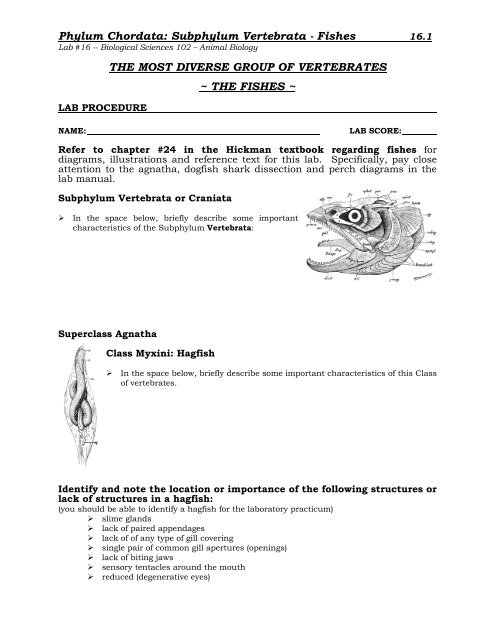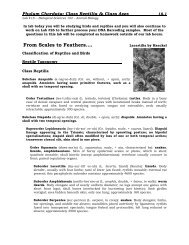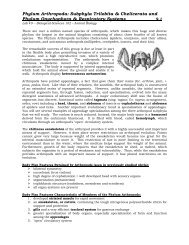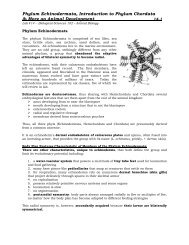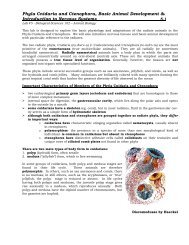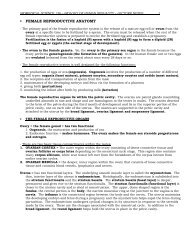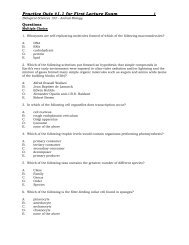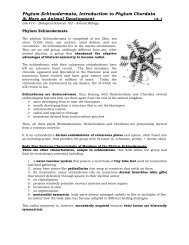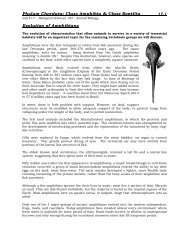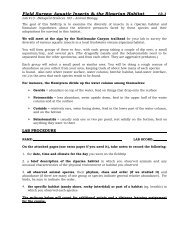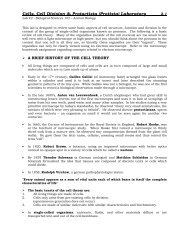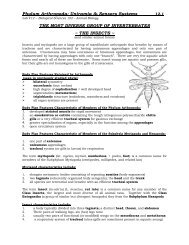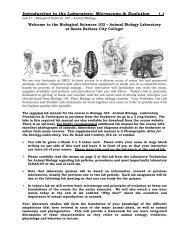Phylum Chordata: Subphylum Vertebrata - Fishes ... - Biosciweb.net
Phylum Chordata: Subphylum Vertebrata - Fishes ... - Biosciweb.net
Phylum Chordata: Subphylum Vertebrata - Fishes ... - Biosciweb.net
- No tags were found...
Create successful ePaper yourself
Turn your PDF publications into a flip-book with our unique Google optimized e-Paper software.
<strong>Phylum</strong> <strong>Chordata</strong>: <strong>Subphylum</strong> <strong>Vertebrata</strong> - <strong>Fishes</strong> 16.1Lab #16 -- Biological Sciences 102 – Animal BiologyLAB PROCEDURETHE MOST DIVERSE GROUP OF VERTEBRATES~ THE FISHES ~NAME:LAB SCORE:Refer to chapter #24 in the Hickman textbook regarding fishes fordiagrams, illustrations and reference text for this lab. Specifically, pay closeattention to the agnatha, dogfish shark dissection and perch diagrams in thelab manual.<strong>Subphylum</strong> <strong>Vertebrata</strong> or Craniata‣ In the space below, briefly describe some importantcharacteristics of the <strong>Subphylum</strong> <strong>Vertebrata</strong>:Superclass AgnathaClass Myxini: Hagfish‣ In the space below, briefly describe some important characteristics of this Classof vertebrates.Identify and note the location or importance of the following structures orlack of structures in a hagfish:(you should be able to identify a hagfish for the laboratory practicum)‣ slime glands‣ lack of paired appendages‣ lack of of any type of gill covering‣ single pair of common gill apertures (openings)‣ lack of biting jaws‣ sensory tentacles around the mouth‣ reduced (degenerative eyes)
<strong>Phylum</strong> <strong>Chordata</strong>: <strong>Subphylum</strong> <strong>Vertebrata</strong> - <strong>Fishes</strong> 16.2Lab #16 -- Biological Sciences 102 – Animal BiologySuperclass AgnathaClass Cephalaspidomorphi: Lamprey‣ In the space below, briefly describe some importantcharacteristics of this Class of vertebrates.Your instructor will briefly review with you the basic lifecycle of a typicallamprey.‣ How does an ammocoete larva of a lamprey differ from Amphioxus (a cephalochordate)in its basic structure?Identify and note the location or importance of the following structures orlack of structures in a lamprey:(you should be able to identify a lamprey for the laboratory practicum)‣ lack of paired appendages‣ single, median nasal aperture (opening)‣ horny teeth around mouth‣ lack of any scale covering‣ 7 pairs of external gill apertures(openings)‣ moderately developed eyes
<strong>Phylum</strong> <strong>Chordata</strong>: <strong>Subphylum</strong> <strong>Vertebrata</strong> - <strong>Fishes</strong> 16.3Lab #16 -- Biological Sciences 102 – Animal BiologySuperclass Gnathostomata‣ How do members of the Superclass Agnatha differ from members of the SuperclassGnathostomata?‣ Regarding the basic classification of fishes, be sure you are aware ofthe major distinguishing characteristics specific to each of thefollowing taxa – see the poster and lab handout:‣ Class Chondrichthyes‣ Subclass Elasmobranchii‣ Subclass Holocephali‣ Class Sarcopterygii‣ Class Actinopterygii‣ Provide the taxonomy from Superclass to Superorder for each of thefollowing fishes: (this may require that you check ITIS or the posterdisplayed in lab).SalmonSuperclassClassSubclassSuperorderRatfishSuperclassClassSubclassDogfish (Squalus)SuperclassClassSubclass
<strong>Phylum</strong> <strong>Chordata</strong>: <strong>Subphylum</strong> <strong>Vertebrata</strong> - <strong>Fishes</strong> 16.4Lab #16 -- Biological Sciences 102 – Animal BiologySturgeonSuperclassClassSubclassSurf PerchSuperclassClassSubclassManta RaySuperclassClassSubclassLampreySuperclassClassGoldfishSuperclassClassSubclassSuperorderExamine the model of the coelacanth, Latimeria chalumnae on display.‣ What anatomical features might have preadapted the ancestors of this modern speciesfor a terrestrial existence?
<strong>Phylum</strong> <strong>Chordata</strong>: <strong>Subphylum</strong> <strong>Vertebrata</strong> - <strong>Fishes</strong> 16.5Lab #16 -- Biological Sciences 102 – Animal Biology‣ Fish ClassificationOf the nearly 51,000 different species of vertebrates, nearly 24,000 arethe various fish species<strong>Phylum</strong> <strong>Chordata</strong> (chordates)Suphylum <strong>Vertebrata</strong> (vertebrates; cranium and spinal column/backbone)Superclass Agnatha (jawless vertebrates; cartilaginous skeletonwith persistent notocord; lack paired fins)Class Myxini (hagfishes; four pairs of tentacles aroundmouth; nasal sac with duct to pharynx; slime glandspresent; poorly developed eyes)Class Cephalaspidomorphi (lampreys; buccal funnel withkeratinized teeth; nasal sac not connected to pharynx;fairly well developed eyes)Superclass Gnathostomata (jawed vertebrates; pairedappendages present; partial or complete replacement ofnotocord with centra (body) of spinal column)Class Chondrichythes (fish with a cartilaginous skeleton;teeth not fused to jaw; no swim bladder; spiral valve inintestines; claspers in males)Subclass Elasmobranchii (sharks, skates & rays;placoid scales usually present; five to seven gillarches & slits; upper jaw not fused to cranium)Subclass Holocephali (chimaeras & ratfishes; scalesabsent; four gill slits covered by an operculum;upper jaw fused to cranium)Class Actinopterygii (ray-finned fishes; ossifiedskeleton; single gill opening covered by an operculum;paired fins supported by dermal rays; limb musculature withinbody; swim bladder mainly a hydrostatic organ)Subclass Chondrostei (bichirs, paddlefishes &sturgeons; heterocercal caudual fin, ganoid scales ifpresent; spiral valve in intestines)Subclass Neopterygii (gars, bowfin, teleosts; bonyskeleton; caudal fin usually homocercal; scalesusually cycloid or ctenoid; fin ray number equal totheir supports in dorsal and anal fins) = most fishClass Sarcopterygii (lobe-finned fishes; ossified skeleton;single gill opening covered by operculum; paired finswith internal skeleton and musculature within the limb;diphycercal tail; spiral valve in intestines; usuallylung-like swim bladder)
<strong>Phylum</strong> <strong>Chordata</strong>: <strong>Subphylum</strong> <strong>Vertebrata</strong> - <strong>Fishes</strong> 16.7Lab #16 -- Biological Sciences 102 – Animal BiologyFISH SPECIMEN OBSERVATION:For at least 8 of the live or preserved specimens displayed in the lab indicate the following:1. GenusClassCommon Name2. GenusClassCommon Name3. GenusClassCommon Name4. GenusClassCommon Name5. GenusClassCommon Name6. GenusClassCommon Name7. GenusClassCommon Name8. GenusClassCommon Name
<strong>Phylum</strong> <strong>Chordata</strong>: <strong>Subphylum</strong> <strong>Vertebrata</strong> - <strong>Fishes</strong> 16.8Lab #16 -- Biological Sciences 102 – Animal BiologyDOGFISH (Squalus) SHARK DISSECTIONRefer to exercise #18 in your lab manual regarding these dissections.External Structures (entire fish)‣ nostril‣ eye‣ mouth‣ spiracle‣ external gill slits (how many are there?)‣ lateral line‣ claspers (which sex has these?)‣ caudal peduncle‣ cloaca‣ ampullae/organs of Lorenzini‣ dorsal fins (anterior and posterior)‣ pectoral fins‣ pelvic fin‣ caudal fin‣ Why is the dorsal side of the shark darker in color relative to the ventralside?Internal Structures‣ liver‣ Why is the liver so important to buoyancy in sharks?Abdominal Organs‣ stomach‣ rugae of stomach‣ duodenum‣ spiral valve‣ colon‣ rectal gland‣ spleen‣ pancreas (inferior to stomach)‣ gallbladder‣ testes‣ seminal vesicles (males)‣ ovaries (females)‣ ductus deferens (males)‣ oviducts (females)
<strong>Phylum</strong> <strong>Chordata</strong>: <strong>Subphylum</strong> <strong>Vertebrata</strong> - <strong>Fishes</strong> 16.9Lab #17 -- Biological Sciences 102 – Animal Biology – Spring 2006‣ What is the importance of the spiral valve relative to digestive processes in sharks?Thoracic Organs‣ heart‣ gill arches‣ gill rakers‣ gill filamentsCranial Structures‣ eye‣ brain‣ optic nerve‣ spinal cord‣ otolithsLABORATORY NOTES ON THE SQUALUS DISSECTION:
<strong>Phylum</strong> <strong>Chordata</strong>: <strong>Subphylum</strong> <strong>Vertebrata</strong> - <strong>Fishes</strong> 16.10Lab #17 -- Biological Sciences 102 – Animal Biology – Spring 2006PERCH, ROCKFISH OR OTHER BONY FISH DISSECTIONRefer to exercise #18 in your lab manual regarding these dissections.External Structures (entire fish)‣ nostril‣ eye‣ mouth‣ operculum‣ lateral line‣ caudal peduncle‣ cloaca‣ dorsal fins (anterior and posterior)‣ pectoral fins‣ pelvic fin‣ caudal fin‣ anal finLABORATORY NOTES ONTHE BONY FISH DISSECTION:Internal StructuresAbdominal Organs‣ swim/air bladder‣ liver‣ stomach‣ pyloric cecum‣ intestine‣ testes (males)‣ ovaries (females)‣ oviducts (females)Thoracic Organs‣ heart‣ gill arches‣ gill rakers‣ gill filamentsCranial Structures‣ eye‣ brain‣ spinal cordTypes of fish caudal finsTeleostei by Haeckel


